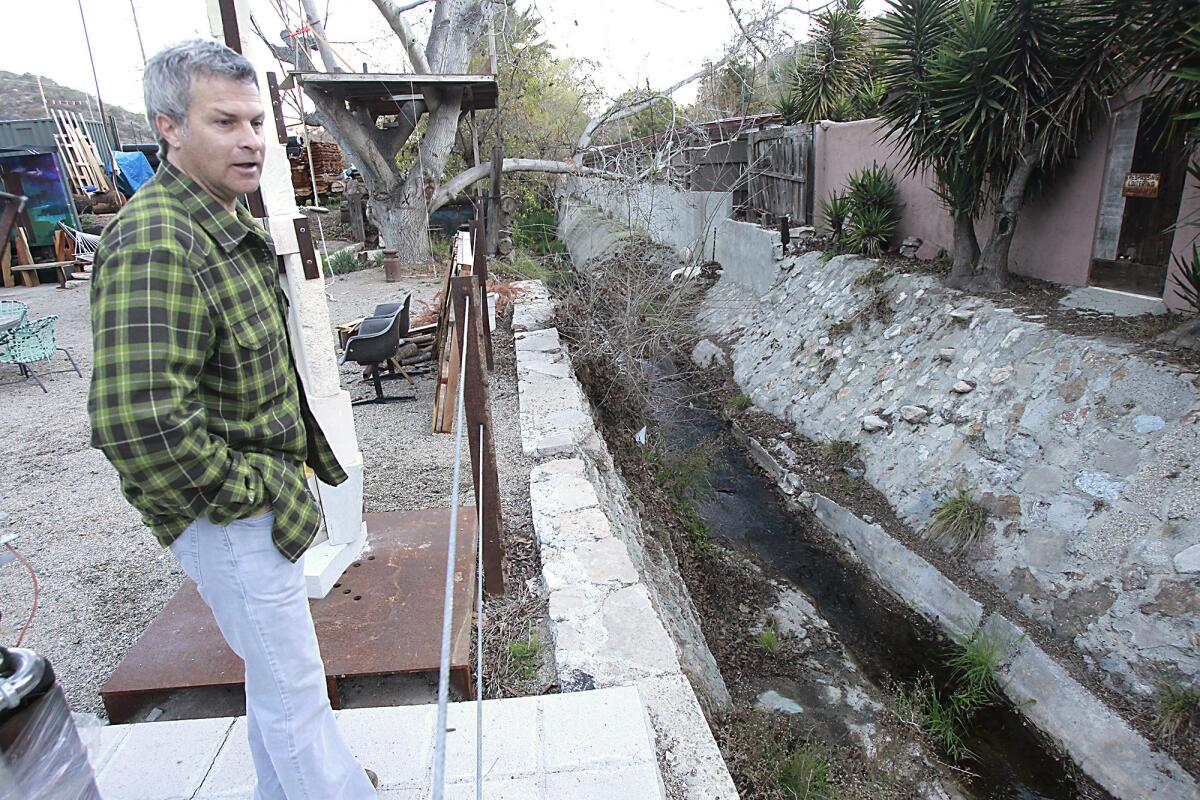Laguna work/live project could get new court date

Sculptor Louis Longi, in 2014, stood at the creek area where his artist live-work project would be built.
- Share via
An Orange County Superior Court judge next week will hear arguments for and against whether to retry a case involving a proposed 30-unit artist work/live project in Laguna Beach.
Attorneys representing sculptor Louis Longi and business partner Chris Dornin are seeking a new trial, claiming in court papers that Judge Kim Dunning “usurped” the California Coastal Commission’s role and “made her own independent determination” in a ruling in September.
That is when she decided that the commission had erred in approving a coastal development permit in January 2015 for the project, which was to have been built on two parcels, at 20412 and 20432 Laguna Canyon Road.
She said the commission failed to prove — by substantial evidence — that the 0.84-acre complex of two two-story buildings would satisfy setback requirements and questions of scale.
Dunning also considered the hearing an “unfair process” because six of 10 commissioners failed to properly disclose private communications with developers and yet subsequently voted on the project, according to the ruling.
Coastal commissioners in recent months have been subjected to scrutiny by courts and the media for failing to report private meetings or reporting them late or with little detail, according to the Los Angeles Times. Such ex parte communications open the possibility of backroom deal-making, say critics.
Friends of the Canyon, comprised of Laguna residents, sued the commission in March 2015, a little more than a year after the Laguna Beach City Council approved the Longi-Dornin project on a 3-2 vote.
The project generated heated debate in Laguna. Proponents lauded the idea as a way for artists to work and live in a city known for the arts but also for pricing out many of the people who create it.
But two key issues continued to surround the proposed project: its setback from Laguna Canyon Creek and whether it fits the rural, small-scale nature of the canyon, an area that features a mix of houses and businesses. Opponents said the facility would be too large for the space and would harm the creek.
Allan Cooper, an attorney representing Longi and Dornin, claimed that rather than examining evidence presented to the commission, Dunning conducted an independent investigation “because [she] did not like staff’s statement that the creek was not identifiable on the map,” according to a motion filed with the court, referring to the map of the state’s major watershed drainage course.
A location designated as being on the map generally means that any construction be at least 25 feet from a creek’s banks instead of 25 feet from the center of the stream.
Commission staff stated three times during the hearing that the creek was not on the map, and therefore the facility’s proposed location for the buildings would suffice, Cooper said.
Attorney Julie Hamilton, who represents Friends of the Canyon, claimed in her opposition brief that three statements from one commission staff member failed to adequately support the agency’s decision.
“It cannot be argued that one sentence of a CCC staff member’s testimony stating, ‘it’s not on the map’ during a CCC hearing, surrounded by two statements made by the same staff member that the creek ‘is not shown on the map’ is substantial evidence,” Hamilton wrote.
The important detail, as articulated by the court in its order, is the finding of whether the creek was or was not on the map — not whether it was shown or identifiable on the map, Hamilton said, referring to the fact that map lines have been open to interpretation.
In her ruling, Dunning said that rustic architecture and landscaping contribute to rural character, but aesthetics do not override the project’s size, scale and density.
But Cooper claimed the commission got it right in approving the project, which satisfied city development and zoning standards.
“The focus on size and density as the criteria for small scale and rural is misplaced,” Cooper wrote. “Small scale means limited in extent or scope. The project clearly meets that definition as artist live/work is of a far lesser extent or scope than, for example, an auto repair facility or a food processing and packaging plant, both of which are allowed in that zone.”
Hamilton offered a different definition of small scale as “of limited size and scope.”
“Surely, size and density are proper indicators of whether a project is small scale and rural,” she wrote. “The LCP does not state that rural and small scale means it is smaller than other projects that are allowed in the project site’s zone.”
LCP refers to the Local Coastal Plan, defined by the Coastal Commission as basic planning tools used by local governments to guide development in the coastal zone.
The commission has not made a determination on the request for a new trial yet, spokeswoman Noaki Schwartz wrote in an email.
Dunning will hear arguments at a hearing that starts at 8:30 a.m. Dec. 15 at 751 W. Santa Ana Blvd., Santa Ana.
Twitter: @AldertonBryce
